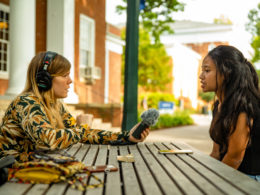If an organization has been around since 1877, it must be doing something right. Family Lifeline has been bringing health and hope to Central Virginia’s most vulnerable families for well over a century through partnerships with community organizations that provide health and wellness support and resources.
Katina Williams is a newer face at this old organization. Originally serving in the role of vice president of long-term support services, she recently became president and CEO at the end of 2020. We caught up with Williams to learn more about her role at Family Lifeline, the services the organization offers and how it impacts the community.

What is Family Lifeline’s core mission?
Family Lifeline’s core mission is strengths-focused and life-changing. We partner with families and individuals, delivering intensive home and community-based services to build an equitable, resilient community where families and individuals are connected, safe, and living a healthy, meaningful life. Family Lifeline is committed to providing services that are trauma informed, inclusive, equitable, and diverse.
Family Lifeline has been hard at work for more than a century. Our longevity, in part, comes from the fact that we are responsive to the changing needs of those we serve. Rooted in our history and driven by best practices, Family Lifeline delivers all of our services, not in an office, but in the homes and communities of those who need them the most. By engaging families in a familiar place, a place where they experience their daily successes and challenges, we maximize the development of wellbeing, independence, and a true, caring reciprocal relationship.
While we seek positive change, family resiliency and equity, we are well aware of the inequity that has existed in our community since our founding in 1877 and recognize the impact systemic racism plays in that inequity. As an organization, we seek and have embraced racial equity and inclusion.
Can you characterize the extent of the problem Family Lifeline addresses in our community?
Our Growing Well programming provides intensive home visitation services to families who face a variety of issues – poverty, unemployment and social isolation – that place them in an at-risk category. These risk factors can significantly jeopardize a family’s ability to provide a safe, stable and nurturing home that supports healthy growth and development. Many of the families who could benefit from our services live in communities plagued by health inequities, racial disparities and adverse childhood experiences. Research shows that early childhood experiences, both positive and negative, have a tremendous impact on health, development and lifelong learning.
We seek healthier babies, healthier moms, engaged dads and stronger families positioned to support and encourage success in their children. The first three years of life are critical in a child’s emotional and physical development. During these years, children get many of the basic learning patterns and abilities that they will build upon for the rest of their lives.
Family Lifeline’s Living Well programming for older adults, persons with disabilities and their caregivers strives to help individuals remain living well in community settings of their choosing where they feel safe, connected, healthy and engaged.
Research shows that frailty and chronic conditions increase sharply with age. This places the ever-growing senior population at great risk of becoming dependent on others for care including carrying out the everyday tasks necessary to age-in-place and remain safely at home. An individual’s ability to remain safely in their homes is typically measured by the need for help in activities of daily living such as walking, dressing, and bathing as well as, instrumental activities like preparing a hot meal and making telephone calls.
Loneliness and social isolation are associated with multiple physical and mental health risks for older adults. Isolation is the experience of diminished social connectedness where the impact of risk factors outweighs the impact of any existing protective factors. Our goal is to support older adults to remain socially engaged while maintaining their health, safety and dignity. Without Family Lifeline’s services, these clients would be at risk for costly care such as hospitalization and/or nursing home placement.
What don’t most people realize or understand?
The demand for in-home care among low-income older adults and people with disabilities far exceeds the affordable supply. The PCA and CNA workers, commonly referred to as aides, who provide services to this population are undervalued and under compensated in this industry. Yet they are critical to the care of older adults and people with disabilities and provide support for daily living, in addition to helping them navigate complex systems, like Medicaid and Social Security. In some cases, our workers are the only ones there. Regardless of the tremendous value they bring to our society by caring for some of our most vulnerable citizens, these workers face multiple obstacles to meeting their own basic family needs. Services for the low-income recipients of in-home care are reimbursed at rates too low to properly compensate our workers. These workers deserve a living wage, something that Family Lifeline is advocating for.
Health inequities and racial disparities run deep in the lives of those served through our Growing Well programming. Black women have a higher maternal mortality rate than their counterparts. The infant mortality rate among Black mothers is higher as well. One of the primary elements of our programming is supporting access to healthcare, a key component to positive birth outcomes. Equitable treatment by the healthcare system is critical to positive outcomes as well. Applying a racial justice lens to maternal care, partnerships among providers who support Black mothers and increased investment in critical support systems and programming would go a long way to eliminating these disparities. Family Lifeline is a strong proponent and advocate for eliminating these disparities.
What kind of work do volunteers do to help Family Lifeline?
Through our Living Well programming, we recruit volunteers from the community to spend one hour a week with older adults. With our Visiting Volunteers program, we strive to meet the social and emotional needs of some older adults and persons with disabilities. Through weekly visits, the program matches program participants with volunteers who provide companionship, outreach, and advocacy. Volunteers receive formal training focusing on person centered engagement and sensitivity to the needs of individuals facing difficult life circumstances (e.g., health issues, grief, etc.). These vital supports increase the opportunity for older adults to remain in housing of their choosing for as long as possible by reducing loneliness and isolation.
If $100,000 fell from the sky tomorrow, how would you spend it?
Oh wow, what we could do! First, we would launch our community engagement plan for the organization. Listening to the voices of those with lived experience would be a powerful tool for informing our programming. Authentic integration of lived experience provides knowledge, insight, and perspectives to the improvement and expansion of current services and would be instrumental in shaping new programming. Funding would help provide needed resources and supports to help those willing to participate. Childcare and other supports could reduce obstacles for participation that are often overlooked but critical to families holding more than one job. Compensating them would help honor the value of their participation. We would also create a staff position to help guide, coach and mentor those participating.
To learn more about Family Lifeline, watch the video below – or visit its website or Facebook page. You can also donate directly here.










